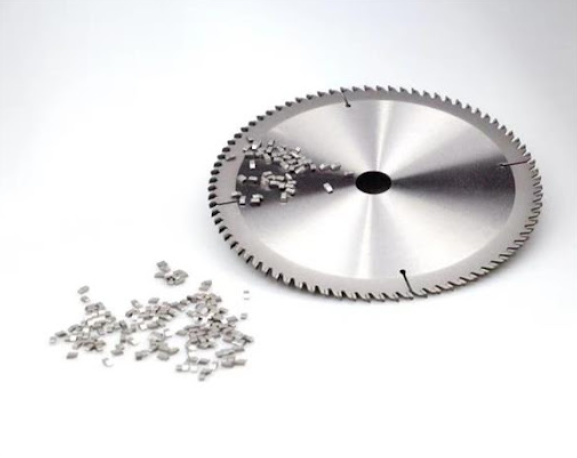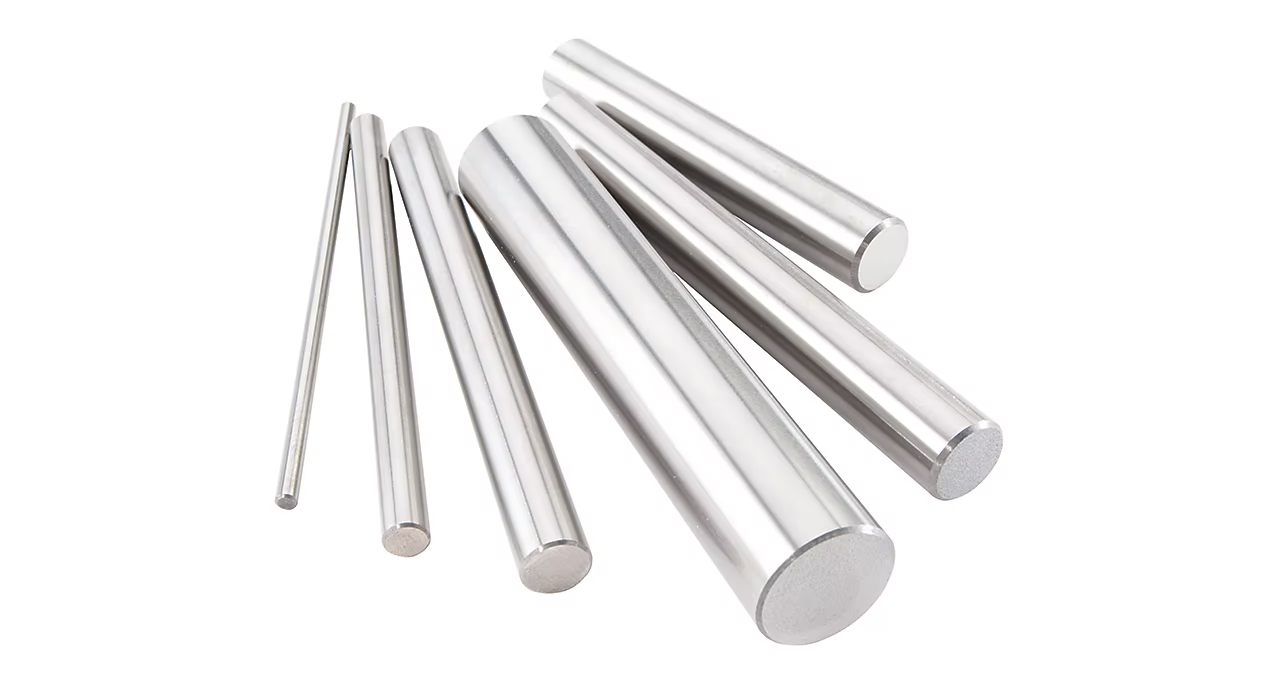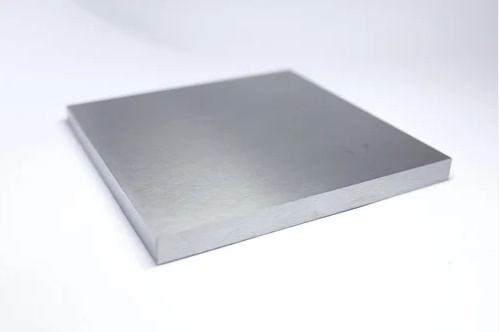소개
절삭 공구의 영역에서 톱날의 재질은 성능, 내구성, 효율성을 결정짓는 중요한 요소입니다. 카바이드 톱 팁텅스텐 카바이드로 만든 톱날은 다양한 산업 분야에서 톱날과 절삭 공구를 위한 최고의 선택으로 부상했습니다. 이 블로그에서는 다른 재료에 비해 초경 톱날을 사용할 때 얻을 수 있는 수많은 이점을 살펴보고, 초경 톱날의 고유한 특성과 절단 작업에 가져다주는 이점을 강조합니다.
카바이드 톱 팁이란?
카바이드 톱 팁은 톱날의 톱니에 부착된 작고 단단한 부품입니다. 일반적으로 뛰어난 경도와 내마모성으로 잘 알려진 텅스텐 카바이드로 만들어집니다. 이 팁은 목재와 플라스틱부터 금속과 복합재에 이르기까지 다양한 재료를 절단할 때 가혹한 조건을 견딜 수 있도록 설계되었습니다.

카바이드 톱 팁의 장점
1. 탁월한 경도와 내구성
카바이드 톱 팁은 경도가 매우 높아 내구성에 크게 기여하는 것으로 알려져 있습니다. 텅스텐 카바이드는 다이아몬드 다음으로 가장 단단한 재료 중 하나입니다. 이 뛰어난 경도 덕분에 초경 톱 팁은 고속강(HSS)이나 공구강과 같은 다른 재료로 만든 팁보다 훨씬 더 오랫동안 날카로움과 절삭날을 유지할 수 있습니다.
2. 뛰어난 내마모성
카바이드 톱 팁의 두드러진 특징 중 하나는 뛰어난 내마모성입니다. 이 특성 덕분에 팁은 큰 마모 없이 장시간의 절삭을 견딜 수 있습니다. 카바이드 팁의 내마모성은 공구 수명 연장으로 이어져 교체 및 유지보수 빈도를 줄여줍니다.
3. 높은 절단 효율
카바이드 톱 팁은 절단 효율이 높기 때문에 고속 절단 작업에 이상적입니다. 카바이드의 날카로움과 경도는 더 부드럽고 빠른 절단을 가능하게 하여 필요한 노력과 에너지를 줄여줍니다. 이러한 효율성은 생산성과 정밀도가 가장 중요한 산업 환경에서 특히 유용합니다.
4. 다양한 소재의 활용성
카바이드 톱 팁은 다양한 재료를 쉽게 절단할 수 있는 매우 다재다능한 제품입니다. 목재, 플라스틱, 비철금속, 심지어 단단한 금속까지 카바이드 팁은 일관된 성능을 제공합니다. 이러한 다용도성 덕분에 목공 및 금속 가공부터 건설 및 제조에 이르기까지 다양한 산업에서 선호되는 선택입니다.
5. 내열성
절단 작업 중 톱 팁은 마찰로 인해 고온에 노출됩니다. 카바이드 톱 팁은 내열성이 뛰어나 고온에서도 경도와 절단 효율을 유지합니다. 이러한 특성은 팁 변형을 방지하고 까다로운 조건에서도 일관된 절단 성능을 보장합니다.
6. 정밀도 및 마감 품질
카바이드 톱 팁의 날카로움과 안정성은 뛰어난 정밀도와 마감 품질에 기여합니다. 카바이드 팁은 버링이나 거친 모서리를 최소화하면서 깔끔하게 절단하여 완제품의 전반적인 품질을 향상시킵니다. 이러한 정밀도는 정확성과 세밀한 마감이 필수적인 분야에서 매우 중요합니다.
7. 시간 경과에 따른 비용 효율성
카바이드 톱 팁은 다른 재료에 비해 초기 비용이 높을 수 있지만, 수명이 길고 성능이 뛰어나 장기적으로 비용 효율적입니다. 공구 수명이 연장되고 유지보수 요구 사항이 줄어들어 전체 비용이 절감되므로 가성비가 뛰어납니다.
8. 향상된 도구 안정성
카바이드 톱 팁의 강성과 강도는 절삭 작업 중 공구 안정성을 향상시킵니다. 이러한 안정성은 진동과 편향을 최소화하여 보다 정확하고 일관된 절단을 가능하게 합니다. 또한 향상된 안정성은 공구 파손이나 오작동 가능성을 줄여 작업자의 안전에도 기여합니다.
카바이드 톱 팁과 다른 재료 비교
카바이드 톱 팁의 장점을 더 잘 이해하기 위해 절삭 공구에 일반적으로 사용되는 다른 재료와 비교해 보겠습니다:
표: 톱 팁 재료 비교
| 속성 | 카바이드 톱 팁 | 고속 강철(HSS) | 공구강 |
|---|---|---|---|
| 경도 | 매우 높음 | 보통 | 보통 |
| 내마모성 | 우수 | 양호 | 공정 |
| 내열성 | 우수 | 양호 | 보통 |
| 절단 효율성 | 높음 | 보통 | 보통 |
| 내구성 | 우수 | 양호 | 보통 |
| 비용 | 높은 초기 비용, 장기적으로 비용 효율적 | 초기 비용 절감, 교체 빈도 증가 | 적당한 초기 비용, 적당한 교체 주기 |
| 다용도성 | 높은 활용성 | 다용도 | 활용도가 떨어짐 |
| 마감 품질 | 우수 | 양호 | 공정 |
설명: 이 표는 초경 톱팁의 주요 특성을 고속강(HSS) 및 공구강과 비교하여 강조합니다. 초경 톱 팁은 경도, 내마모성, 내열성 및 전반적인 절삭 효율에서 다른 재질을 능가하므로 까다로운 절삭 작업에 선호되는 선택입니다.
카바이드 톱 팁의 응용 분야
카바이드 톱 팁은 다양한 산업과 응용 분야에서 사용되며 탁월한 성능과 신뢰성을 제공합니다. 카바이드 톱 팁이 탁월한 몇 가지 주요 분야는 다음과 같습니다:
1. 목공
- 경목 및 연목 자르기: 카바이드 팁은 경목과 연목 모두에서 깨끗하고 정밀하게 절단할 수 있어 고급 목공 및 캐비닛에 이상적입니다.
- 고급 마감 만들기: 카바이드 팁의 날카로움과 안정성은 목재 표면의 매끄러운 마감을 보장하여 최종 제품의 미적 품질을 향상시킵니다.
2. 금속 가공
- 비철금속 절단: 초경 팁은 알루미늄 및 구리와 같은 비철금속 절단에 매우 효과적이며 깨끗하고 효율적인 절단을 제공합니다.
- 단단한 금속 가공: 카바이드 팁의 경도와 내구성은 스테인리스 스틸과 같은 단단한 금속 절단에 적합하여 긴 공구 수명과 일관된 성능을 보장합니다.
3. 플라스틱 절단
- 플라스틱 부품 성형: 카바이드 팁은 플라스틱 시트와 부품 절단 및 성형에 탁월하여 최소한의 버링으로 정밀한 절단을 제공합니다.
- 플라스틱 제품 제조: 카바이드 팁의 다용도성으로 다양한 플라스틱을 효율적으로 절단할 수 있어 플라스틱 제조의 생산성을 향상시킵니다.
4. 건설
- 콘크리트 및 석조물 절단: 카바이드 팁의 강도와 내구성은 콘크리트나 벽돌과 같은 거친 건축 자재를 절단하는 데 이상적입니다.
- 건물 구성 요소 제작: 카바이드 팁은 건물 구성 요소를 제작할 때 신뢰할 수 있는 성능을 제공하여 정확성과 효율성을 보장합니다.
5. 자동차 산업
- 자동차 부품 제조: 카바이드 팁은 자동차 부품 생산에 사용되어 정밀한 절삭을 제공하고 고품질 부품을 보장합니다.
- 금속 및 플라스틱 부품 절단: 카바이드 팁의 다목적성으로 금속 및 플라스틱 부품을 효율적으로 절단할 수 있어 자동차 산업의 다양한 요구 사항을 충족합니다.
6. 항공우주
- 항공우주 소재의 정밀 절단: 카바이드 팁은 항공우주 소재 절단에 필요한 정밀도를 제공하여 항공기 부품의 품질과 신뢰성을 보장합니다.
- 항공기 부품 제작: 카바이드 팁의 내구성과 내마모성은 항공우주 제조의 까다로운 조건에 적합합니다.
카바이드 톱 팁의 혁신
최근 카바이드 톱 팁 기술의 발전으로 성능과 활용성이 더욱 향상되었습니다. 혁신은 다음과 같습니다:
1. 고급 코팅
카바이드 팁에 질화 티타늄(TiN) 또는 다이아몬드 유사 탄소(DLC)와 같은 고급 코팅을 적용하면 내마모성과 절삭 효율이 향상됩니다. 이러한 코팅은 마찰을 줄이고 재료 접착을 방지하며 공구의 수명을 연장하는 보호층을 제공합니다.
2. 맞춤형 지오메트리
이제 제조업체는 특정 절삭 조건과 재료에 맞는 맞춤형 형상의 카바이드 팁을 생산할 수 있습니다. 이러한 맞춤화는 최적화된 성능과 효율성을 보장하여 다양한 산업의 고유한 요구 사항을 충족합니다.
3. 스마트 기술
IoT 지원 공구와 같은 스마트 기술을 통합하면 카바이드 톱 팁의 실시간 모니터링과 예측 유지보수가 가능합니다. 이러한 기술은 전반적인 공구 성능을 향상시키고 가동 중단 시간을 줄이며 생산성을 향상시킵니다.
자주 묻는 질문
Q1: 카바이드 톱 팁이 다른 재료보다 내구성이 뛰어난 이유는 무엇인가요?
A1: 카바이드 톱 팁은 텅스텐 카바이드로 만들어져 매우 단단하고 내마모성이 뛰어납니다. 이 소재는 고속강이나 공구강과 같은 다른 소재보다 훨씬 더 오랫동안 날카로움과 절삭날을 유지하므로 내구성이 뛰어나고 공구 수명이 연장됩니다.
Q2: 카바이드 톱 팁은 절단 효율을 어떻게 향상시키나요?
A2: 카바이드 톱 팁의 날카로움과 경도로 인해 더 부드럽고 빠르게 절단할 수 있어 필요한 노력과 에너지가 줄어듭니다. 이러한 높은 절단 효율은 생산성과 정밀도가 중요한 산업 환경에서 특히 유용합니다.
Q3: 카바이드 톱 팁을 단단한 금속 절단에 사용할 수 있습니까?
A3: 예, 카바이드 톱 팁은 스테인리스 스틸과 같은 단단한 금속 절단에 매우 효과적입니다. 뛰어난 경도와 내마모성으로 까다로운 절삭 작업에 적합하며 일관된 성능과 수명을 보장합니다.
Q4: 카바이드 톱 팁이 장기적으로 더 비용 효율적입니까?
A4: 카바이드 톱 팁은 다른 재료에 비해 초기 비용이 높지만 공구 수명이 길어지고 유지보수 요구 사항이 줄어들어 시간이 지남에 따라 비용 효율성이 높아집니다. 수명이 길고 일관된 성능으로 전체 비용이 낮아져 뛰어난 가성비를 제공합니다.
Q5: 카바이드 톱 팁 기술의 최신 혁신은 무엇인가요?
A5: 최근 카바이드 톱 팁 기술의 혁신에는 내마모성과 절삭 효율을 향상시키는 티타늄 질화물(TiN) 및 다이아몬드 유사 탄소(DLC) 같은 고급 코팅이 포함됩니다. 특정 절삭 조건에 맞는 맞춤형 형상과 실시간 모니터링 및 예측 유지보수를 위한 스마트 기술의 통합도 주목할 만한 발전입니다.
카바이드 팁 톱 팁을 좋은 가격에 구매하고 싶으신가요? 클릭하세요 여기.




